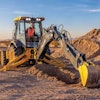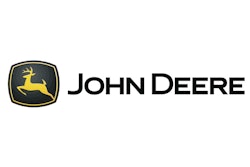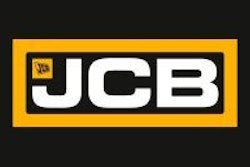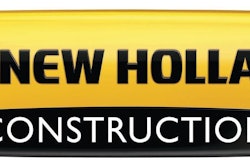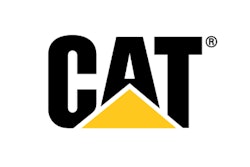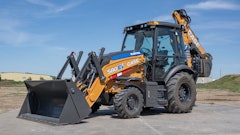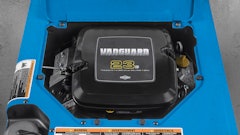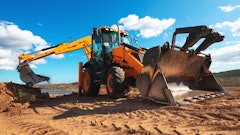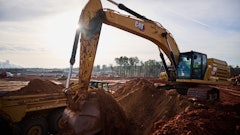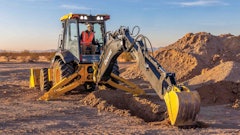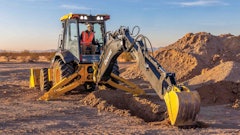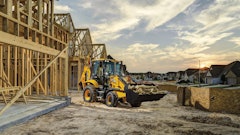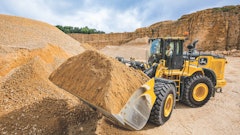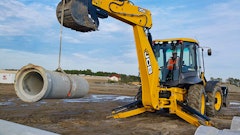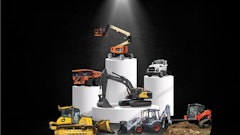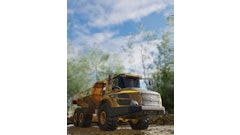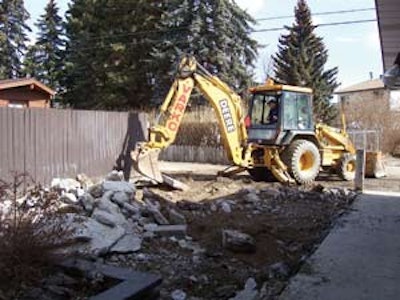
It is very difficult to classify the role of the backhoe-loader. "They are one of the most versatile pieces of equipment you can own," says Bob Garber, Dixie Excavating. "The only thing that limits what you can do is your time."
This multipurpose nature makes it difficult to optimize one machine to match every need. Each end user's application is going to emphasize different performance criteria.
"For example, if a customer only uses his front loader for loading loose, stockpiled material, breakout force would not be as critical as perhaps bucket capacity and lift force," says Kevin Hershberger, senior project consultant, backhoe-loaders, Caterpillar. "A customer doing production backhoe trenching would be more interested in hydraulic pump flow, hydraulic system design, specs and backhoe bucket design."
Diverse demands, different views
Dayton-OH-based Dixie Excavating performs commercial development work, including underground utilities and streets, land clearing, sanitary sewer and water. To gain maximum versatility, the company uses the IT integrated tool carrier version of the Caterpillar 430 equipped with ride control.
"Right now, I am mainly using it to fill ditches behind the sanitary and water main lines," says Garber. "I am basically using it as a loader."
In addition to the front bucket, the company owns forks. Rental houses provide brooms and other attachments on an as-needed basis.
An extendible dipperstick also comes in handy for trenching. "You can get dirt farther away from the trench," says Garber.
Garber doesn't place much emphasis on spec sheets during the decision-making process. Instead, dealer support and resale value are primary considerations. Dixie Excavating is currently on a four- or five-year replacement cycle.
Art Tucker Excavating, a sewer and water contractor in St. Clair Shores, MI, based its decision to purchase a JCB 215s backhoe-loader primarily on its lifting capacity. "When we set catch basins and manhole sections, we have no problem," says Art Tucker. The 215s handles this task better than previous models the contractor has owned.
Tucker compared specs from several manufacturers. One of the competitors offered decent lifting performance, but it was too heavy for his application. "Sometimes we do get into soft terrain," he explains.
H.M. Environmental, Mt. Clemmins, MI, is an environmental contractor performing underground storage tank removal, site remediation, exploratory excavating, site demolition and miscellaneous cleanups. Lifting performance helps drive its backhoe-loader choice, as well. The machines must be able to handle some of the underground storage tanks the company encounters.
Currently, H.M. Environmental owns two backhoe-loaders, including a JCB unit, as well as an excavator. Due to the diversity of its work, the company regularly rents equipment for larger jobs to minimize the amount of iron sitting in the yard.
H.M. Environmental counts on its backhoe-loaders to help it remain cost competitive by minimizing the use of larger equipment where possible. The rubber tires also reduce disturbance to the existing environment compared to steel track.
Varko Contracting and Excavating Inc. in Calgary, Alberta, Canada, performs residential and commercial foundation work, excavation and backfilling and sidewalk and curb and gutter maintenance. Due to this wide range of projects, the company demands maximum versatility from its five John Deere 410 backhoe-loaders. "We utilize them completely — we use the whole machine," says Attila Varga, president.
To get optimum productivity, the contractor equips its 410s with extendible dippersticks, auxiliary hydraulics on the backhoe and ride control.
The City of Rock Hill, SC, currently owns 11 backhoe-loaders, including five New Holland LB 75s purchased last year. "We are in the utility business — electric, water and sewer," says Marty Burr, performance manager. "We repair streets, sidewalks and curbs. We use it for so many varied operations."
Versatility also rules in this case. Consequently, the machines are equipped with an extendible dipperstick with hydraulics to the end of the stick, ride control and a four-in-one bucket on the loader.
By the numbers
Most of these contractors started the decision-making process by comparing printed specifications. "It is a good estimate of what the machine will do," says Jay Barth, JCB. "It is a good starting point."
Yet, it's important to make sure the numbers are all measured in a comparable manner. "It is critical to be sure you are comparing specs according to the same standards — for example, that values are stated using SAE or ISO rules for reporting," says Hershberger.
Also check to make sure the numbers actually stack up. "Every so often, there can be specs that show one competitor is way ahead of another," says Bob Tyler, product marketing manager, backhoes, John Deere Construction and Forestry Division. "That's the time to check ‘apples to apples', such as net vs. gross horsepower, or even the small print relative to lift specs.
Some lift specs are quoted as the total amount a machine can lift, and some use the SAE J31 reporting system that quotes 87% of maximum lift."
Of course, specs only go so far. "Published specs are a reasonable way to get an ‘apples-to-apples' comparison of relative machine capacity.But they are not very good indicators of some of the more subjective factors that separate the best machines from the pack," says Hershberger. "Operator station comfort, ergonomics and hydraulic system performance are best understood during actual operation of the machine."
Published specs also don't reflect many important design elements. "For example, items like structure design, hose routings, serviceability, dealer support and factory parts distribution do not show up in a specs comparison," says Hershberger.
Fuel-efficient options
You may want to factor recent volatility in the fuel supply into your decision-making process. "Europe has been very concerned about fuel consumption for many years," says Eric Winkler, New Holland. "We are starting to see more of a trend here, especially in the United States, where people are looking at fuel consumption more than ever before."
Barth agrees, noting, "It hasn't reached the level that you might see in some European markets, but it is a concern. It is something people are starting to take note of."
Matching the power available to the true need is one avenue to increase fuel economy. "With fuel prices skyrocketing, people are starting to look at whether they really need a 15-ft. machine with 110 gross hp, or do they need something that is under 100 hp that still gives them the ability to do what their 15-ft. machine has done in the past," says Winkler. New Holland has responded by adding a 15-ft. backhoe that produces 95 gross hp to its lineup.
Engine horsepower is often not the best performance measure. "More often than not, just looking at the engine horsepower may not show the whole story," says Tyler. "There needs to be enough to be able to reverse out of a spoil pile, put the machine in forward and simultaneously lift the loader bucket over the sides of the truck, for example. But a machine that has more horsepower may cause you to burn more fuel than you need if you're mainly spending time trenching with the backhoe."
Other options, such as the Torque Lock recently released as an option on JCB's six-speed autoshift transmissions, also yield gains in fuel efficiency. At road speed, the torque converter is locked solidly. "That gives you two things," says Barth. "There is less variability in your travel speed. On any given trip from Point A to Point B, you are going to get there faster because you don't have the torque converter changing speed. The other thing is that it translates into fuel savings. You can throttle back and actually achieve the same travel time at a lower engine speed, which is more fuel efficient."
Pilot controls adapt to operators
"Pilot controls deliver smooth, low-effort controllability for more operator comfort and reduced fatigue levels," says Hershberger. "Nearly all applications can benefit from this. The backhoe industry is now experiencing the conversion trend that has already occurred in the excavator industry as more customers experience the benefits and value of pilot controls."
"Many applications benefit from pilot controls," agrees Tyler, "not so much from being any faster than manual controls, but more from the fact that operator fatigue is greatly reduced. As a result, the operator can work longer in a day or take fewer breaks since he or she remains comfortable while working. Lever efforts are lower and lever travels are shorter, both of which keep the operator from tiring as quickly."
Pilot controls also allow the operator to switch between excavator and backhoe control patterns. H.M. Environmental counts on this flexibility to maintain its productivity. "We are kind of stuck on excavator controls," says Steve Matthes, H.M.
Environmental. If his operators have to switch to backhoe controls, it slows production. "You are used to doing it one way; now you have to do everything backwards."
Varga at Varko Contracting and Excavating appreciates the ability to change control patterns from the cab with the flip of a switch. But he is trying to teach all of his operators to use the excavator controls so there will be only one pattern used across all of his equipment.
"I have all my backhoe operators accustomed to operating the pilot controls with the excavator control pattern," says Varga.
"That way I can have them jumping back and forth between a backhoe and an excavator. Having everybody able to operate everything is kind of my plan."
Open- vs. closed-center hydraulics
The debate between open-center and closed-center hydraulic systems is complicated, and the correct choice depends on who you talk to. "There are genuine pros and cons to both systems," says Barth. Both sides claim you can get good "feel" through the system.
Varko Excavating likes the closed-center system because it replicates the feel of an excavator. "As an owner/operator, I went with the 410 because in the field it felt more like an excavator to me than a backhoe," says Varga. "When I started on my own, it was after operating excavators for several years. So I've always had a piston pump. It is more the excavator-style hydraulics."
Varga feels the closed-center system delivers smoother operation. "The gear pump is a little more on and off," he explains. "I just don't find that you have as much control over it. We do some work around gas lines, electrical lines and live utilities and we want to be able to get close to them and have good control of the machine."
However, Winkler counters, "An open-center system gives the operator more feel because the system has continuous flow on our mechanical units. The pilot units use an open-center system with a closed-center valve, which gives the operator better feel with better functionality."
Barth adds, "A properly designed gear pump [open] system can be very efficient and operate with a high degree of performance. From a longevity and repair standpoint, it can be very cost effective. In other words, they have a very low repair cost."
The closed-center systems are load sensing and provide flow through piston pumps only when needed. The pump will be on standby except when it is being used. This translates into fuel savings. But the componentry in the system is more expensive, and the piston pumps run tight tolerances, which places an emphasis on fluid cleanliness.
Delivering more traction
Four-wheel-steer backhoe-loaders with equal-size tires fill a niche in the market. For example, Winkler views New Holland's four-wheel steer B115 as more of a wheel loader when equipped with the standard 1.5-cu.-yd. bucket. The four larger, equal-sized tires provide better ground clearance and flotation.
"The popularity of our S machine — which is four-wheel drive, four-wheel steer with four equal-size tires — is with guys who are going into rough-terrain applications and need to operate when the weather is sub par," says Barth of JCB's S models.
The tractive effort of these machines is much greater. For example, the ability to access difficult sites to excavate with the backhoe is an advantage. However, the application that first comes to mind would be as a loader, says Barth. "If you have to go from Point A to Point B over rough terrain, there is no equal to it," he states.
H.M. Environmental takes advantage of the extra load height on the front of these machines stemming from the larger front tires. "You get another 8 in. of loading height with your front loader," says Matthes. This additional clearance comes in handy for loading gravel trains.
Factor in the dealer and service issues
While backhoe-loader performance specifications and options differentiate machines, dealer support and warranty arguably play an even greater role.
"Probably 60% of the decision to purchase a certain brand from a certain person is the dealer and my relationship with them, in particular the sales people," says Garber at Dixie Excavating.
The service department is also critical. "I use the dealer to do my maintenance," says Garber. "I don't carry a mechanic." Benefits go beyond not having to fight for technicians, which are in short supply. "They have the records of your machine when you get ready to sell it or trade it in."
Preventing costly downtime is another issue. "One of the biggest things I really look at is warranty of the machine," says Burr. "We are on a five-year rotation now. We have never done that before. We used to keep them until they would not run any longer."
Finally, don't overlook the actual operating costs. "Service intervals are also important in order to know how often you are going to change oils, for example," says Tyler. "Over a three-year period, service items such as oil and filters can add up. A machine that needs servicing half as often as a competitor can really help to lower daily operating costs."




